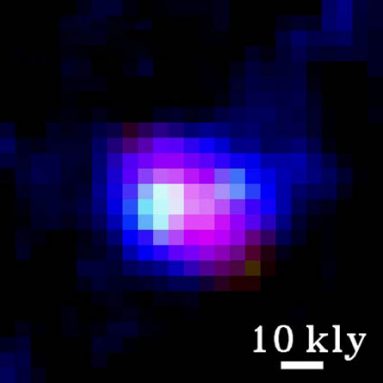The hungry blob at the edge of the universe
Scientists have observed one of the oldest objects in the sky, possibly a galaxy in a growth spurt
 |
|
This blob of glowing gas and stars (shown in a false color image) is from roughly 13 billion years ago, a time shortly after the universe formed. In the bar shown for scale, 10 kly stands for 10,000 light-years.
|
| M. Ouchi et al., Astrophysical Journal |
Using a telescope atop a Hawaiian mountain, astronomers recently caught sight of an enormous, newfound glowing object in deep, deep space. If you were an astronomer, what would you call such a thing?
How about a “blob”?
Technically, the object is called a Lyman-alpha blob, and scientists aren’t exactly sure what it is. But they have a guess. Astronomer Masami Ouchi, of the Observatories of the Carnegie Institution for Science in Pasadena, Calif led the team that identified the blob. He and his colleagues think it may be a distant galaxy — a collection of stars, gas and dust — caught in the act of a feeding frenzy.
Astronomers have different theories to explain how blobs like Ouchi’s came into being. Some suggest that Lyman-alpha blobs are smaller galaxies merging together into one larger galaxy. Other theories suggest cold gas streaming into the galaxy is essentially “feeding” it. Still other astronomers suspect that the glowing blob is a cloud of gas heated by a nearby supermassive black hole.
The galaxy is 12.9 billion light-years from Earth. Light travels at about 186,000 miles per second, so one light-year is the equivalent of about 5.9 trillion miles. The giant blob is very, very far away, about 76.1 billion trillion miles away, in case you’re counting. In fact, it’s so far away that it’s the fourth most distant object ever observed.
When we see light from a distant object in the sky — say, a star — we’re not seeing the object as it is. We’re seeing the object as it was when it emitted the light we’re seeing now. For example, light takes about eight minutes to travel from the sun to Earth, so when you see the sun, you actually see it as it was eight minutes ago.
In other words, to look into space is to look back in time. Because the newly discovered blob is 12.9 billion light-years away, it is at least 12.9 billion years old. The universe itself is believed to be about 13 or 14 billion years old, so this blob came into being not long after.
The blob is about 55,000 light-years across, or about half the diameter of our own galaxy, the Milky Way. To observe the blob, Ouchi and his team used a special telescope that is able to see infrared light coming from space. Infrared light is made of waves with wavelengths that we cannot see with the naked eye. We can feel these waves, though: “Far” infrared radiation feels like heat.
According to Ouchi’s infrared measurements, the number of stars in the blob is equivalent to 40 billion suns. And that number is likely to keep growing since the scientists think the blob is a young galaxy in a growth spurt.







